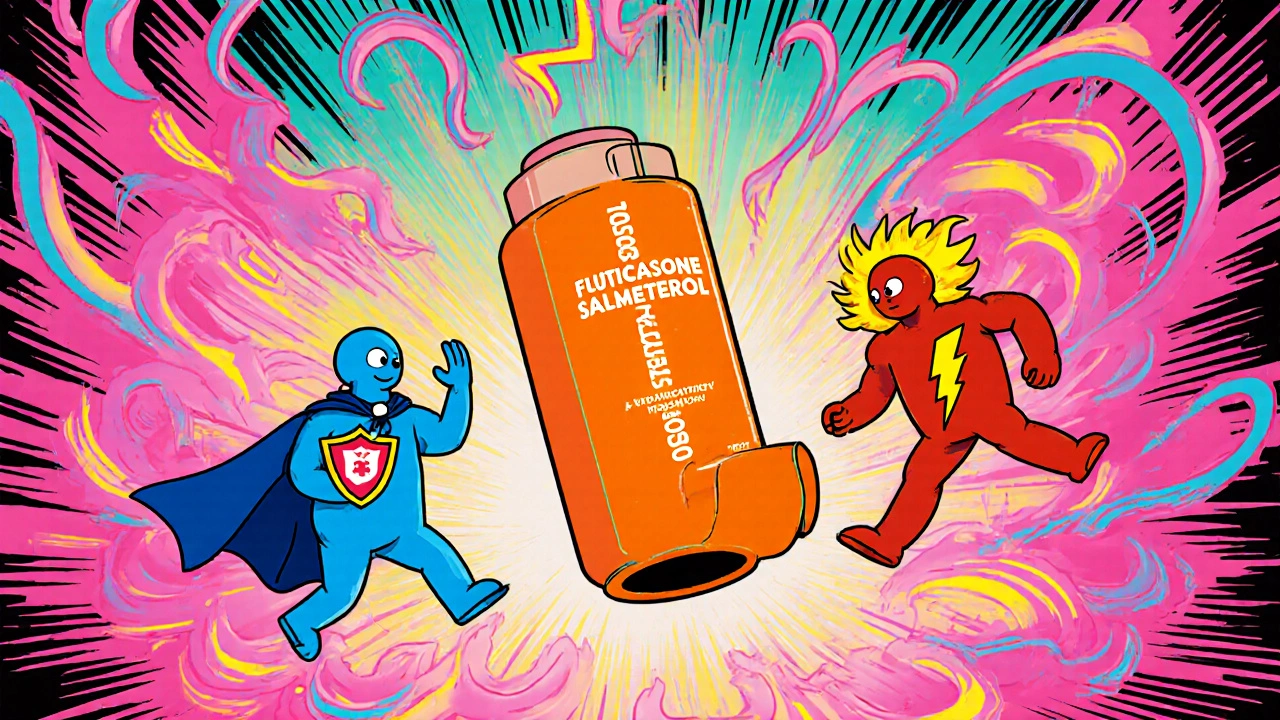Fluticasone‑Salmeterol: Everything You Need to Know
When working with fluticasone‑salmeterol, a fixed‑dose inhaler that blends an inhaled corticosteroid with a long‑acting beta‑agonist to control airway inflammation and keep bronchi open. Also known as Advair, Seretide, it’s prescribed for chronic lung diseases like asthma, a condition marked by reversible airway narrowing and COPD, a progressive blockage of airflow. This combo inhaler works because the corticosteroid component reduces swelling while the beta‑agonist relaxes smooth muscle.
Why the Two‑Drug Combo Works
The inhaled corticosteroid, fluticasone in this case, targets airway inflammation at the source. Meanwhile the long‑acting beta agonist, salmeterol, provides sustained bronchodilation for up to 12 hours. Together they address both pillars of chronic respiratory disease: inflammation and constriction. The partnership also lets doctors use lower doses of each ingredient, which can lower the chance of systemic side effects compared with taking either drug alone.
Because the inhaler delivers medication directly to the lungs, the systemic exposure is much less than oral steroids. This is why many clinicians favor the combo for patients who need daily control but want to avoid the weight gain, bone loss, or glucose spikes linked to oral corticosteroids. The dual action also means fewer rescue inhaler puffs, which can improve quality of life and reduce emergency visits.
Choosing the right device matters too. Fluticasone‑salmeterol comes as a dry‑powder inhaler (DPI) that requires a steady, deep inhalation. Patients who struggle with coordination may benefit from a breath‑actuated device or a spacer. Proper technique—exhaling fully, sealing lips around the mouthpiece, inhaling quickly and holding breath for ten seconds—maximizes deposition in the lower airways and minimizes oral residue.
Side effects are generally mild but worth watching. The most common complaint is oral thrush, a yeast infection that thrives on leftover powder. Rinsing the mouth with water and spitting it out after each use cuts that risk dramatically. Hoarseness and cough can also appear, especially if the inhaler isn’t cleared properly. A small subset of patients report systemic effects like adrenal suppression, especially at high doses or when combined with strong CYP3A4 inhibitors such as ritonavir or ketoconazole.
Drug interactions deserve a quick look. Fluticasone is metabolized by the liver enzyme CYP3A4, so medications that block this enzyme can raise fluticasone levels and increase the chance of side effects. On the flip side, strong inducers like rifampin can lower drug concentrations, potentially reducing asthma or COPD control. Always flag any new prescription, over‑the‑counter product, or herbal supplement with your pharmacist.
Monitoring is simple but essential. Most doctors schedule lung‑function tests (spirometry) every six months to gauge how well the inhaler is keeping the airways open. If symptoms flare up—more wheezing, night‑time coughing, or increased rescue inhaler use—it's a sign the dose may need adjustment or another medication might be added.
Below you’ll find a curated list of articles that dig deeper into each of these topics. From withdrawal guides for other drugs to detailed side‑effect breakdowns, the collection gives you practical tips and trustworthy comparisons to help you stay on top of your respiratory health.
Understanding How Fluticasone‑Salmeterol Works: The Science Behind This Asthma Inhaler
Explore the science behind fluticasone‑salmeterol, how its steroid and bronchodilator work together, dosing, safety, and FAQs for asthma and COPD patients.
